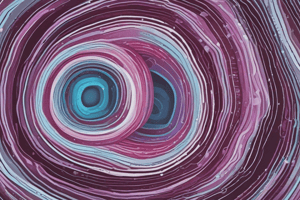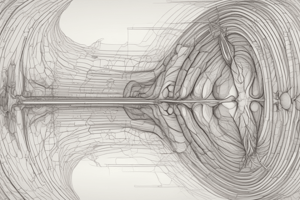Podcast
Questions and Answers
Which of the following is a recognized indication for performing a micturating cystourethrography (MCU)?
Which of the following is a recognized indication for performing a micturating cystourethrography (MCU)?
- Detection of renal calculi
- Assessment of bladder wall thickness
- Evaluation for vesicoureteric reflux (correct)
- Measurement of prostate size
What is a contraindication to performing a micturating cystourethrography (MCU)?
What is a contraindication to performing a micturating cystourethrography (MCU)?
- History of bladder trauma
- Acute urinary tract infection (correct)
- Suspected urethral stricture
- Neurogenic bladder
During an MCU, which type of contrast material is typically utilized?
During an MCU, which type of contrast material is typically utilized?
- Barium sulfate
- Microbubble contrast
- High osmolar contrast material (HOCM) (correct)
- Gadolinium-based contrast
What piece of equipment is essential for performing micturating cystourethrography (MCU)?
What piece of equipment is essential for performing micturating cystourethrography (MCU)?
Prior to undergoing a micturating cystourethrography (MCU), what preparation step should the patient take?
Prior to undergoing a micturating cystourethrography (MCU), what preparation step should the patient take?
During micturating cystourethrography (MCU), why is intermittent monitoring with fluoroscopy important during the early bladder filling phase?
During micturating cystourethrography (MCU), why is intermittent monitoring with fluoroscopy important during the early bladder filling phase?
In the context of performing a micturating cystourethrography (MCU) on a male patient, why is an oblique or lateral projection preferred during micturition?
In the context of performing a micturating cystourethrography (MCU) on a male patient, why is an oblique or lateral projection preferred during micturition?
When performing a micturating cystourethrography (MCU), which additional view is taken to identify any undetected reflux into the kidneys?
When performing a micturating cystourethrography (MCU), which additional view is taken to identify any undetected reflux into the kidneys?
In which clinical scenario would a lateral view be most useful during a micturating cystourethrography (MCU)?
In which clinical scenario would a lateral view be most useful during a micturating cystourethrography (MCU)?
During a micturating cystourethrography (MCU), what is the utility of stress views within the context of urodynamic studies?
During a micturating cystourethrography (MCU), what is the utility of stress views within the context of urodynamic studies?
After a micturating cystourethrography (MCU), what common side effect should patients be warned about?
After a micturating cystourethrography (MCU), what common side effect should patients be warned about?
How are the antibiotic doses adjusted for children receiving antibiotics for a recent urinary tract infection when undergoing micturating cystourethrography (MCU)?
How are the antibiotic doses adjusted for children receiving antibiotics for a recent urinary tract infection when undergoing micturating cystourethrography (MCU)?
Which of the following is a potential complication associated with micturating cystourethrography (MCU)?
Which of the following is a potential complication associated with micturating cystourethrography (MCU)?
What measure can be taken to prevent bladder perforation as a complication during bladder filling in micturating cystourethrography (MCU)?
What measure can be taken to prevent bladder perforation as a complication during bladder filling in micturating cystourethrography (MCU)?
What is a potential complication during catheterization for micturating cystourethrography (MCU), especially in female patients?
What is a potential complication during catheterization for micturating cystourethrography (MCU), especially in female patients?
What action should be taken if a patient experiences dysuria after undergoing micturating cystourethrography (MCU)?
What action should be taken if a patient experiences dysuria after undergoing micturating cystourethrography (MCU)?
For pediatric patients undergoing micturating cystourethrography (MCU), what is a primary indication that is almost exclusively confined to children?
For pediatric patients undergoing micturating cystourethrography (MCU), what is a primary indication that is almost exclusively confined to children?
During micturating cystourethrography (MCU), when should the catheter be removed from the patient's bladder?
During micturating cystourethrography (MCU), when should the catheter be removed from the patient's bladder?
For infants and children with a neuropathic bladder undergoing micturating cystourethrography (MCU), how may micturition be facilitated?
For infants and children with a neuropathic bladder undergoing micturating cystourethrography (MCU), how may micturition be facilitated?
Following a micturating cystourethrography (MCU), most children will already be on antibiotics for a recent urinary tract infection. What adjustment to the dosage and course of antibiotics is typical in this scenario?
Following a micturating cystourethrography (MCU), most children will already be on antibiotics for a recent urinary tract infection. What adjustment to the dosage and course of antibiotics is typical in this scenario?
Flashcards
Vesicoureteric reflux
Vesicoureteric reflux
Backflow of urine from the bladder into the ureters.
Micturating Cystourethrography
Micturating Cystourethrography
Used to visualize the urethra while urinating.
Contrast medium for VCUG
Contrast medium for VCUG
High or Low osmolar contrast material (HOCM or LOCM) at 150 mg I mL-1 is used.
Fluoroscopy equipment
Fluoroscopy equipment
Signup and view all the flashcards
Patient preparation for VCUG
Patient preparation for VCUG
Signup and view all the flashcards
Contraindication to VCUG
Contraindication to VCUG
Signup and view all the flashcards
Preliminary image
Preliminary image
Signup and view all the flashcards
Catheter removal in VCUG
Catheter removal in VCUG
Signup and view all the flashcards
Aftercare for VCUG
Aftercare for VCUG
Signup and view all the flashcards
Urinary tract infection
Urinary tract infection
Signup and view all the flashcards
Study Notes
- Micturating cystourethrography is an imaging technique.
Indications
- The procedure is indicated for vesicoureteric reflux.
- It helps in studying the urethra during micturition.
- It identifies bladder leaks post-surgery or trauma.
- It aids in urodynamic studies, like those for incontinence.
Contraindications
- An acute urinary tract infection will prevent the procedure from being performed.
Contrast Medium
- High osmolar contrast material (HOCM) or LOCM at a concentration of 150 mg I mL−1 is used.
Equipment
- A fluoroscopy unit with spot film device and tilting table is needed.
- A video recorder is required for urodynamics.
- A bladder catheter is essential.
Patient Preparation
- The patient should empty their bladder before the examination.
Preliminary Image
- A coned view of the bladder is taken.
Technique
- To demonstrate vesico-ureteric reflux, a condition almost exclusively confined to children, aseptic technique is used to catheterize the bladder, and residual urine is drained.
- Contrast medium (150 mg I mL-1) is slowly injected or dripped in with the patient supine.
- Bladder filling is observed by intermittent fluoroscopy.
- Early filling is monitored by fluoroscopy to detect catheter malposition in the distal ureter or vagina.
- Intermittent monitoring identifies transient reflux, which must be recorded.
- The catheter is not removed until the radiologist confirms the patient can micturate, tolerate further infusion, or until contrast medium stops dripping into the bladder.
- Older children and adults receive a urine receiver, while smaller children use absorbent pads.
- Children can lie on the table, while adults may micturate standing.
- Micturition may be achieved by suprapubic pressure in infants and children with a neuropathic bladder.
- Spot images are taken during micturition to record any reflux; video recording can be useful.
- The lower ureter is best seen in the anterior oblique position of the affected side.
- Boys should micturate in an oblique or lateral projection to capture images of the entire urethra.
- A full-length view of the abdomen demonstrates any undetected reflux of contrast medium into the kidneys and records postmicturition residue.
- Lateral views can help when fistulation into the rectum or vagina is suspected.
- Oblique views are needed when evaluating for leaks.
- Stress views are used for urodynamic studies.
Aftercare
- Although special aftercare is unnecessary, it's important to warn patients and their parents that dysuria and potential urinary retention may occur.
- A simple analgesic and warm baths may help.
- Most children receiving antibiotics for a recent urinary tract infection should have their dosage doubled for three days, starting the day before the procedure.
- Children not already on antibiotics typically receive a 3-day course.
Complications
- Urinary tract infection (UTI) is possible.
- Catheter trauma may cause dysuria, frequency, hematuria, and urinary retention.
- Complications from bladder filling can include perforation from overdistension.
- The use of a nonretaining catheter, such as Jacques catheter, may help prevent this.
- Catheterization can result in the catheterization of the vagina or an ectopic ureteral orifice.
- Retention of a Foley catheter may occur.
Studying That Suits You
Use AI to generate personalized quizzes and flashcards to suit your learning preferences.



